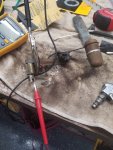After talking to the guy at the alternator shop, I've kind of decided a direction to go.
He said the alternator was a 24V model but that really doesn't mean anything without a 24 volt regulator. It just has denser windings so it can put out more. So basically, it'll put out, to a point, what it's regulated to. So, being that the regulator used here apparently does 0-63v on the field, I'm guessing hitting 32 volts or so from the Delco should not a problem for it. And seeing how it ran like this for years without any problems, that seems like a fairly solid assumption. He also said that this particular model alternator was produced by GM during the 50s-60s (no internal regulator) and other than the windings, there's brushes, and a rectifier bridge and diodes for AC to DC conversion and that's it. So a very simple "box". Which I pretty much knew from my days as an auto mechanic many moons ago. We used to pull them apart and test components and fix them all the time. Usually a diode was getting weak and "leaking" AC. Back then that was probably about a $3 part.
Considering points of failure, the alternator adds very little baggage. Bearings, brushes and the bridge and diodes. I can probably replace the entire unit for less than $150 if it ever fails.
We also talked about 1 wire (or self exciting) alternators. This is not one of those - natively. But really the only difference between a regular alternator and a self exciting one is the self exciting one has a special regulator that takes advantage of the residual magnetism. So after mulling it all over I kept coming back to the fact that there was no outside source of initial field excitation for the Delco. These guys were also apparently relying on residual magnetism to get the Delco going and once it was going and feeding the field of the MEP, the Basler VR siphoned some of the MEP output to maintain (and regulate) the field on the Delco. And obviously, after sitting for ~15 years, there is no residual magnetism left. And without that residual magnetism, it'll never work by itself. So what I've decided to do is set it up pretty much the same way - with a twist. Rather than relying on residual magnetism, I'm going to add a flash circuit for the Delco using a programmable output from the DSE4620 and a relay. When the diesel starts and hits 1860 RPM, I'll "flash" the Delco field with 24 volts from the batteries. I'm guessing this will take 1-3 seconds to get it going. I should be able to easily wire that up and program one of the DSE's outputs to do that. This way, no matter how long it sits without running, losing residual magnetism is not a concern.
Don't know this for sure but I'm thinking that by not siphoning off current from the MEP to power the field of the MEP, but instead using it to power the field of a much smaller alternator, you are using less current and therefore maximizing the output of the MEP - provided the diesel engine has the HP to do that... and I can only assume that it does since it worked. Not sure how much you are saving on total output of the MEP or if it's even enough to worry about.
Anyway, I think that's what I'm going to plan on doing at this point. I probably won't get the Delco back for another week - probably the week after Thanksgiving. In the meantime, I know that the MEP will make power (94 volts just shoving 24 volts - less the resistance of a 13 ohm resistor - into the MEP field windings) so I see no reason at this point to assume I can't make this thing work reliably. In that vein, I need to pull the motor / main alt. off the skid and get the skid and casing parts blasted. I also need to order a motor controller (so far I still haven't found anything I like better than the DSE4620) and I need to start working on a CAD drawing of the new control panel. I also need to get started on my schematic.







